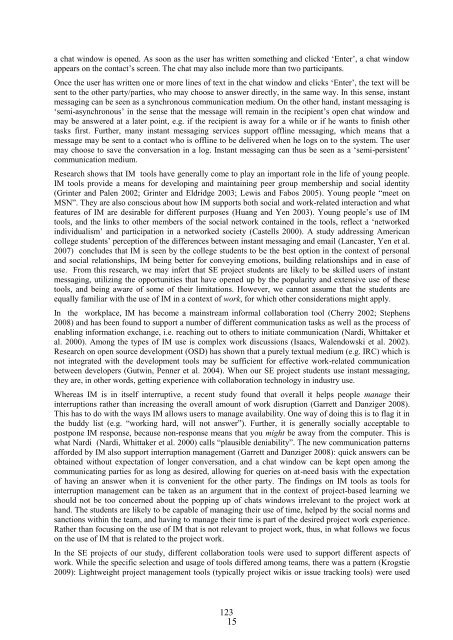The work-reflection-learning cycle - Department of Computer and ...
The work-reflection-learning cycle - Department of Computer and ...
The work-reflection-learning cycle - Department of Computer and ...
Create successful ePaper yourself
Turn your PDF publications into a flip-book with our unique Google optimized e-Paper software.
a chat window is opened. As soon as the user has written something <strong>and</strong> clicked „Enter‟, a chat window<br />
appears on the contact‟s screen. <strong>The</strong> chat may also include more than two participants.<br />
Once the user has written one or more lines <strong>of</strong> text in the chat window <strong>and</strong> clicks „Enter‟, the text will be<br />
sent to the other party/parties, who may choose to answer directly, in the same way. In this sense, instant<br />
messaging can be seen as a synchronous communication medium. On the other h<strong>and</strong>, instant messaging is<br />
„semi-asynchronous‟ in the sense that the message will remain in the recipient‟s open chat window <strong>and</strong><br />
may be answered at a later point, e.g. if the recipient is away for a while or if he wants to finish other<br />
tasks first. Further, many instant messaging services support <strong>of</strong>fline messaging, which means that a<br />
message may be sent to a contact who is <strong>of</strong>fline to be delivered when he logs on to the system. <strong>The</strong> user<br />
may choose to save the conversation in a log. Instant messaging can thus be seen as a „semi-persistent‟<br />
communication medium.<br />
Research shows that IM tools have generally come to play an important role in the life <strong>of</strong> young people.<br />
IM tools provide a means for developing <strong>and</strong> maintaining peer group membership <strong>and</strong> social identity<br />
(Grinter <strong>and</strong> Palen 2002; Grinter <strong>and</strong> Eldridge 2003; Lewis <strong>and</strong> Fabos 2005). Young people “meet on<br />
MSN”. <strong>The</strong>y are also conscious about how IM supports both social <strong>and</strong> <strong>work</strong>-related interaction <strong>and</strong> what<br />
features <strong>of</strong> IM are desirable for different purposes (Huang <strong>and</strong> Yen 2003). Young people‟s use <strong>of</strong> IM<br />
tools, <strong>and</strong> the links to other members <strong>of</strong> the social net<strong>work</strong> contained in the tools, reflect a „net<strong>work</strong>ed<br />
individualism‟ <strong>and</strong> participation in a net<strong>work</strong>ed society (Castells 2000). A study addressing American<br />
college students‟ perception <strong>of</strong> the differences between instant messaging <strong>and</strong> email (Lancaster, Yen et al.<br />
2007) concludes that IM is seen by the college students to be the best option in the context <strong>of</strong> personal<br />
<strong>and</strong> social relationships, IM being better for conveying emotions, building relationships <strong>and</strong> in ease <strong>of</strong><br />
use. From this research, we may infert that SE project students are likely to be skilled users <strong>of</strong> instant<br />
messaging, utilizing the opportunities that have opened up by the popularity <strong>and</strong> extensive use <strong>of</strong> these<br />
tools, <strong>and</strong> being aware <strong>of</strong> some <strong>of</strong> their limitations. However, we cannot assume that the students are<br />
equally familiar with the use <strong>of</strong> IM in a context <strong>of</strong> <strong>work</strong>, for which other considerations might apply.<br />
In the <strong>work</strong>place, IM has become a mainstream informal collaboration tool (Cherry 2002; Stephens<br />
2008) <strong>and</strong> has been found to support a number <strong>of</strong> different communication tasks as well as the process <strong>of</strong><br />
enabling information exchange, i.e. reaching out to others to initiate communication (Nardi, Whittaker et<br />
al. 2000). Among the types <strong>of</strong> IM use is complex <strong>work</strong> discussions (Isaacs, Walendowski et al. 2002).<br />
Research on open source development (OSD) has shown that a purely textual medium (e.g. IRC) which is<br />
not integrated with the development tools may be sufficient for effective <strong>work</strong>-related communication<br />
between developers (Gutwin, Penner et al. 2004). When our SE project students use instant messaging,<br />
they are, in other words, getting experience with collaboration technology in industry use.<br />
Whereas IM is in itself interruptive, a recent study found that overall it helps people manage their<br />
interruptions rather than increasing the overall amount <strong>of</strong> <strong>work</strong> disruption (Garrett <strong>and</strong> Danziger 2008).<br />
This has to do with the ways IM allows users to manage availability. One way <strong>of</strong> doing this is to flag it in<br />
the buddy list (e.g. “<strong>work</strong>ing hard, will not answer”). Further, it is generally socially acceptable to<br />
postpone IM response, because non-response means that you might be away from the computer. This is<br />
what Nardi (Nardi, Whittaker et al. 2000) calls “plausible deniability”. <strong>The</strong> new communication patterns<br />
afforded by IM also support interruption management (Garrett <strong>and</strong> Danziger 2008): quick answers can be<br />
obtained without expectation <strong>of</strong> longer conversation, <strong>and</strong> a chat window can be kept open among the<br />
communicating parties for as long as desired, allowing for queries on at-need basis with the expectation<br />
<strong>of</strong> having an answer when it is convenient for the other party. <strong>The</strong> findings on IM tools as tools for<br />
interruption management can be taken as an argument that in the context <strong>of</strong> project-based <strong>learning</strong> we<br />
should not be too concerned about the popping up <strong>of</strong> chats windows irrelevant to the project <strong>work</strong> at<br />
h<strong>and</strong>. <strong>The</strong> students are likely to be capable <strong>of</strong> managing their use <strong>of</strong> time, helped by the social norms <strong>and</strong><br />
sanctions within the team, <strong>and</strong> having to manage their time is part <strong>of</strong> the desired project <strong>work</strong> experience.<br />
Rather than focusing on the use <strong>of</strong> IM that is not relevant to project <strong>work</strong>, thus, in what follows we focus<br />
on the use <strong>of</strong> IM that is related to the project <strong>work</strong>.<br />
In the SE projects <strong>of</strong> our study, different collaboration tools were used to support different aspects <strong>of</strong><br />
<strong>work</strong>. While the specific selection <strong>and</strong> usage <strong>of</strong> tools differed among teams, there was a pattern (Krogstie<br />
2009): Lightweight project management tools (typically project wikis or issue tracking tools) were used<br />
123<br />
15
















